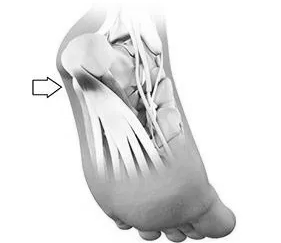Plantar Fasciitis
What is Plantar Fasciitis?
Plantar Fasciitis is a common and uncomfortable problem that causes heel pain.
Plantar Fasciitis refers to inflammation of the plantar fascia, a thick band of tissue that lies at the bottom of the foot. It runs from the heel bone to the toe and forms the arch of your foot.
Who Does Plantar Fasciitis Affect
It is most often seen in middle-aged men and women, but may also occur in those who are constantly on their feet.
Cause of Plantar Fasciitis
The plantar fascia functions as a shock absorber and supports the arch of your foot. Excessive pressure over the fascia may strain and tear the tissue causing heel pain.
Repeated overstretching or overuse causes irritation or inflammation of the fascia.
Other risk factors may include
- Obesity,
- Foot arch problems such as flat feet or high arches,
- Activities such as long-distance running,
- Ballet and dance aerobics,
- Occupations that necessitate walking or standing on hard surfaces for a long period, and
- Wearing shoes with poor arch support or thin-soled shoes.
Symptoms of Plantar Fasciitis
The most common symptom is stabbing pain on the bottom of the foot near the heel.
You experience pain when you take your first steps on awakening and it slowly decreases, but may return after standing or walking for long periods.
Treatment of Plantar Fasciitis
Most patients with plantar fasciitis are effectively treated using a multi-faceted approach possibly including the following measures:
Medications
Treatment can include non-steroidal anti-inflammatory drugs (NSAIDs) to reduce your pain and inflammation.
Corticosteroids can be injected directly into the plantar fascia which may offer pain relief and reduce inflammation.
RICE
To reduce the pain and swelling surrounding the injured area.
- Rest - Rest and Decrease or avoid the activities that worsen the pain to the affected area as more damage could result from putting pressure on the injury.
- Ice - Ice packs should be applied over the affected area for 15-20 minutes every two to three hours during the day. Never place ice directly over the skin.
- Compression - Wrapping with an elastic bandage or an elasticated tubular bandage can help to minimize the swelling and provide support to the injured area.
- Elevation - Elevating the injured area above heart level will also help with swelling and pain
Night Splints:
Use night splints to stretch the plantar fascia and allow it to heal. A patient may need to undergo other treatments to ensure the ongoing health of the foot and ankle.
Supportive Shoes and Orthotics
Your doctor may recommend shoes with good support and cushioning. Custom orthotics (shoe inserts) may also be helpful.
Physical Therapy
Your physical therapist may design an exercise program that focuses on stretching your plantar fascia and Achilles tendon, and strengthening the muscles of the lower leg. In addition to exercises, application of athletic taping to support the bottom of your foot may also help relieve symptoms.
Extracorporeal Shock Wave Therapy
Also known as ECSW, Shockwave Therapy delivers targeting sound impulses into the muscle tissue. This helps damaged or torn soft tissues and stimulates the healing process.
Injection Therapy
In more advanced cases, it is common for physicians to recommend injection therapies. In these treatments, an injection (typically corticosteroids) to reduce inflammation and accelerate the healing.
Platelet-Rich Plasma Therapy
This practice, also known as PRP, involves injecting the site of the injury with the patient's own platelet-rich plasma in an effort to accelerate healing.
Surgery for Plantar Fasciitis
Occasionally, surgery to release the tight plantar fascia may be needed.
Plantar Fascia Surgery (Endoscopic) also known as Endoscopic Plantar Fasciotomy (EPF), is a procedure used to remove a small portion of Plantar Fascia when the fascia becomes tightened or is contracted to cause inflammation and pain.
Minimally invasive forms of this procedure (Percutaneous Tenotomy) are now being performed to reduce surgical risk, but these are not yet available in Australia.
This surgery releases the tension and allows relief from inflammation. The outcome of this procedure is generally good with an overall 90% success rate.






